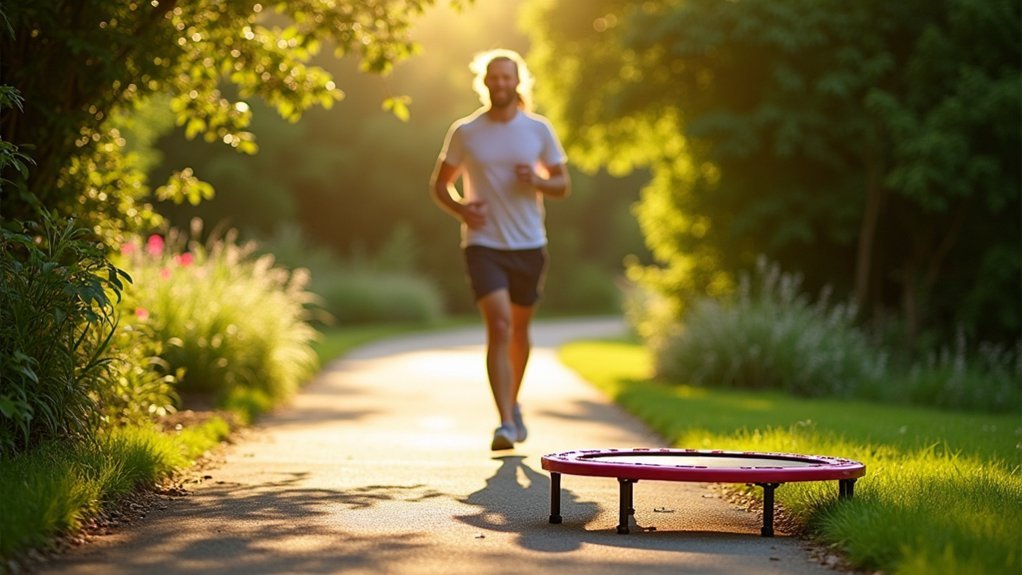Mini-trampolines boost lymphatic flow up to 15 times normal rates through 2-3x body weight G-force impacts, while walking generates only 1.25-1.5x G-force. You’ll benefit most from rebounding 10-15 minutes 3-5 times weekly for intense stimulation, complemented by daily walks for steady circulation support. This combination maximizes immune function and detoxification. The one-way valves in your lymphatic vessels respond differently to each exercise type, creating distinct health advantages worth understanding.
The Science Behind Lymphatic Circulation and Movement

Unlike your cardiovascular system with its powerful heart pump, your lymphatic system relies entirely on physical movement to function properly. This network of vessels and nodes transports lymph fluid, which carries immune cells and removes waste from your tissues.
Your lymphatic system has no natural pump—it needs your movement to circulate immune cells and clear cellular waste.
When you engage in physical activities, muscle contractions create pressure changes that push lymph through one-way valves in your lymphatic vessels.
Rebounding on a mini-trampoline is particularly effective because the alternating gravitational forces during bouncing on a mini-trampoline dramatically enhance lymph flow—up to 15 times more than when you’re sedentary.
Even brief sessions of rhythmic movement stimulate lymphatic circulation, improving immune function throughout your body.
While walking provides beneficial lymphatic stimulation, the vertical movement of rebounding creates more dynamic pressure changes, maximizing the efficiency of your lymphatic system.
Mini-Trampoline Rebounding: Impact on Lymphatic Health
When you step onto a mini-trampoline, you’re activating one of the most effective methods to boost your lymphatic system. The rhythmic bouncing stimulates lymph flow up to 15 times normal rates, greatly enhancing circulation throughout your body.
Just 10 minutes of rebounding 3-5 times weekly can transform your lymphatic health. Each bounce activates the one-way valves in your lymphatic vessels, propelling fluid forward and accelerating detoxification processes.
For those with lymphedema or similar conditions, this gentle exercise promotes fluid movement and reduces swelling.
What makes rebounding particularly powerful is its impact on immune function. Studies show it considerably increases white blood cell count, strengthening your body’s defense mechanisms.
Combine your rebounding routine with deep breathing and a healthy diet to maximize these health benefits and support ideal lymphatic performance.
Walking for Lymphatic Stimulation: Mechanisms and Effects

While mini-trampolines offer excellent bouncing benefits, walking represents one of the most accessible and natural ways to enhance your lymphatic system. Unlike a trampoline, walking creates moderate intensity impact of 1.25-1.5 times your body weight, which promotes bone health while stimulating lymphatic flow.
Each step you take engages your lower leg muscles, acting as a “peripheral heart” that pumps lymphatic fluid throughout your body. These rhythmic muscle contractions facilitate lymphatic drainage and improve circulation of blood cells.
The humble act of walking transforms your leg muscles into auxiliary pumps, circulating vital lymph fluid with each deliberate step.
The continuous movement stimulates your entire system while burning 8-9 calories per minute, supporting weight loss efforts. You’ll reduce risks associated with sedentary lifestyles by walking regularly, which prevents toxin accumulation and enhances immune function.
The natural pumping action of walking efficiently moves lymph fluid, making it an effective daily practice for lymphatic health.
Comparing the G-Force Impact of Both Exercise Methods
Although both activities benefit your lymphatic system, rebounding and walking create markedly different G-force impacts on your body.
When you rebound on a mini trampoline, you experience 2-3 times your body weight in G-force, distributed evenly across both feet. This higher impact greatly stimulates your lymphatic flow, activating your secondary circulatory system more intensely than walking.
Walking generates only 1.25-1.5 times your body weight in G-force, alternating between feet with each step. While still beneficial, this lower impact provides less stimulus to your lymphatic system.
The increased G-force from rebounding engages more muscle groups simultaneously and potentially improves resting metabolic rate more effectively. Your skeletal and muscular systems receive greater strengthening benefits from rebounding’s higher G-force impact, making it particularly effective for enhancing lymphatic flow and overall fitness.
Creating an Optimal Exercise Routine for Lymphatic Support

Understanding G-force differences between rebounding and walking leads naturally to creating a balanced exercise routine that maximizes lymphatic benefits.
Aim to rebound for 10-15 minutes 3-5 times weekly, as it promotes circulation up to 15 times more effectively than rest, greatly enhancing lymphatic flow and immune function.
Complement this with daily walks, which provide sustained, gentle movement that helps improve overall health while supporting lymphatic drainage through lower leg muscle contractions.
Your ideal exercise routine might include morning rebounding sessions for intense lymphatic stimulation, followed by afternoon walks for continued, steady circulation support.
This combination leverages rebounding’s efficiency with walking’s endurance benefits, creating a thorough approach to lymphatic health that minimizes injury risk while maximizing detoxification and immune system support.
Frequently Asked Questions
Is Trampolining Good for Lymphatic Drainage?
Yes, trampolining is excellent for lymphatic drainage. You’ll boost your lymph flow up to 15 times during just a 10-minute session, as the bouncing motion efficiently opens and closes lymphatic valves throughout your body.
What Is the Best Exercise for Lymphatic Drainage?
For lymphatic drainage, rebounding on mini-trampolines is your best option. It increases lymphatic flow up to 15 times in just 10 minutes, though walking is also effective and offers better long-term safety.
What Is 10 Minutes on a Rebounder Equivalent To?
Ten minutes on a rebounder equals roughly 30 minutes of walking for cardiovascular benefits. You’ll stimulate your lymphatic flow 15 times more effectively, burn 80-90 calories, and improve your vestibular system while minimizing joint impact.
Does Walking Help Lymphatic Drainage?
Yes, walking helps lymphatic drainage considerably. Your leg muscles contract rhythmically when you walk, pumping lymph fluid through your system. The moderate impact also stimulates lymphatic flow, supporting your immune function and overall health.
In Summary
You’ve learned that both rebounding and walking stimulate your lymphatic system, just in different ways. Mini-trampolines provide greater g-force impact and vertical movement, while walking offers rhythmic, accessible stimulation. For ideal lymphatic health, don’t choose just one—incorporate both into your routine. Even short sessions will boost circulation, reduce inflammation, and support your immune function. The key is consistency rather than intensity.





Leave a Reply